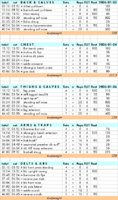I do this on a 2on/1off basis, so this is pretty much equivalent to a 5-a-week split, but not exactly. It boils down to 14 training days on 21, whereas a 5-a-week would be 15 days... Details. I follow this with 20-30 minutes of moderate to low intensity cardio. Goal is leaning out and keeping/adding muscle mass.
Comments?
EDIT: I've updated the images to reflect the supersets. The pairs of exercises marked + or = are supersets. The * indicate single-sided exercised for which the number of reps or sets was doubled on the spreadsheet in order to let the computer properly display time elapsed.
Comments?
EDIT: I've updated the images to reflect the supersets. The pairs of exercises marked + or = are supersets. The * indicate single-sided exercised for which the number of reps or sets was doubled on the spreadsheet in order to let the computer properly display time elapsed.
Attachments
-
226 KB Views: 264
-
184.7 KB Views: 128


